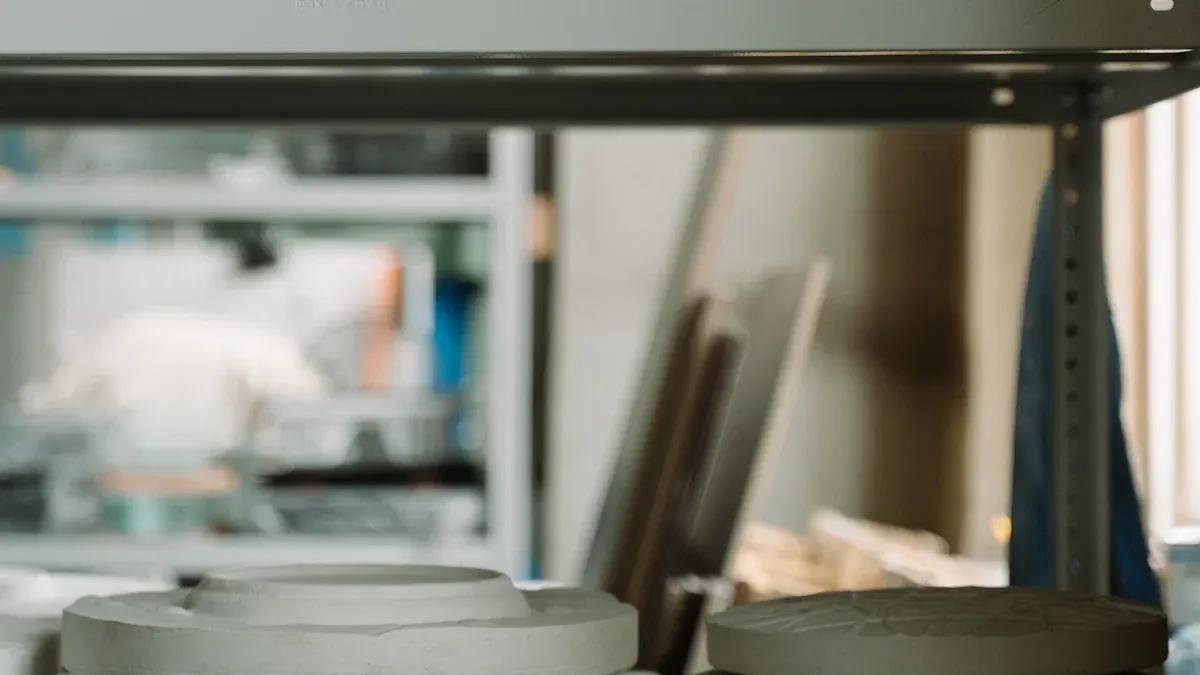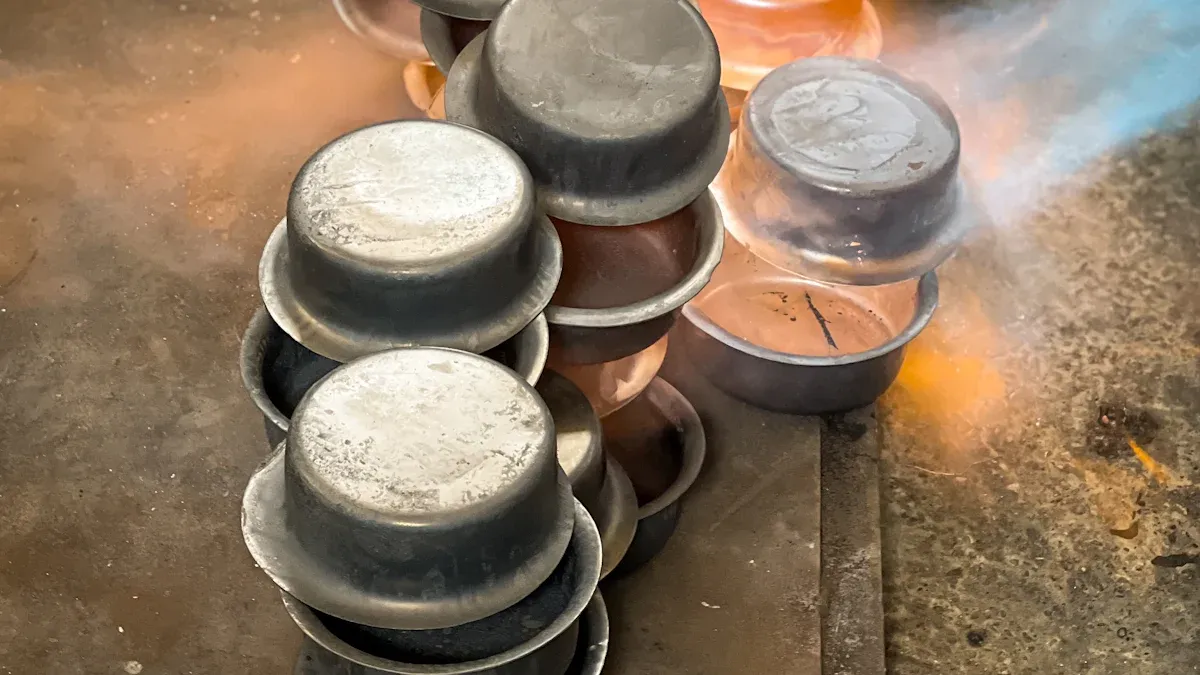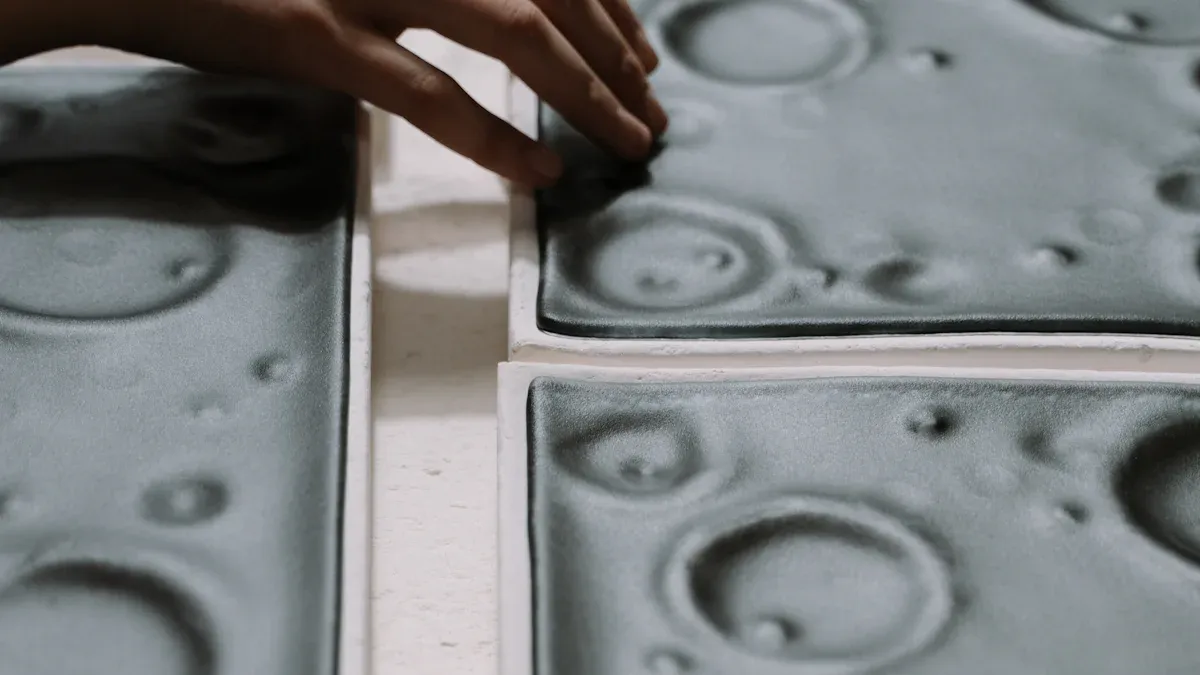
Ceramic injection molding vs metal injection molding highlights a key distinction in the materials used and their resulting properties. Ceramic injection molding uses advanced ceramics to create parts that resist heat and corrosion. Metal injection molding relies on metal powders, producing components with high strength and toughness. Engineers choose ceramic injection molding for applications needing extreme temperature resistance. They select metal injection molding for parts requiring superior mechanical strength.
Ceramic injection molding vs metal injection molding: Process Overview

How Ceramic Injection Molding Works
Ceramic injection molding transforms fine ceramic powders into complex, high-precision components. The process begins with the preparation of a feedstock, which combines ceramic powder with binders and plasticizers. Technicians inject this mixture into a mold using specialized equipment. The process follows several critical stages:
- High-Speed Filling Stage: The feedstock enters the mold at high speed. Shear thinning and viscous heating reduce the viscosity, allowing the slurry to flow and fill intricate mold cavities.
- Low-Speed Filling Stage: The flow slows down, and thermal conduction becomes important. Higher viscosity at this stage helps maintain uniform cooling and prevents defects.
- Holding Pressure Stage: Continuous pressure compacts the slurry, increasing densification and compensating for shrinkage as plasticizers begin to evaporate.
- Demolding Stage: Uniform ejection forces and careful mold design prevent deformation as the part leaves the mold.
Mold temperature and rapid heat cycle molding (RHCM) play a vital role in ceramic injection molding. RHCM improves particle orientation and packing, especially in thicker sections, which reduces shrinkage and defects. Careful control of injection speed, shear rate, holding pressure, cooling rate, and mold design ensures high-quality ceramic parts.
How Metal Injection Molding Works
Metal injection molding (MIM) uses a similar approach but with metal powders. The process starts by blending fine metal powders with binders to create a homogenous feedstock. This mixture is then injected into a mold under high pressure. The main steps include:
- Injection: The metal-binder feedstock fills the mold cavity, forming the desired shape.
- Debinding: The molded part, known as a “green part,” undergoes debinding to remove the binder system, leaving behind a fragile structure.
- Sintering: The debound part is heated in a controlled atmosphere, such as hydrogen or vacuum, to fuse the metal particles. This step densifies the part and imparts its final mechanical properties.
MIM allows for the production of complex geometries with tight tolerances and excellent surface finishes. The process supports a wide range of metals, including stainless steel, titanium, and refractory alloys.
Key Process Differences
Ceramic injection molding vs metal injection molding reveals several fundamental differences in process parameters and material behavior. Ceramic feedstocks typically require lower solids loading than metal feedstocks, resulting in higher shrinkage during sintering. Ceramics are usually sintered in air at higher temperatures, while metals often require hydrogen or vacuum atmospheres.
| Aspect | Ceramic Injection Molding | Metal Injection Molding |
|---|---|---|
| Feedstock Composition | Lower solids loading, higher viscosity | Higher solids loading, lower viscosity |
| Sintering Atmosphere | Air | Hydrogen or vacuum |
| Sintering Temperature | Higher | Lower (relative to ceramics) |
| Mold Design | Shorter flow paths, special gates | Standard gates, longer flow paths |
| Rheology | Shear thinning, abrasive | Less abrasive, different flow |
Ceramic feedstocks demand shear-thinning properties to reduce viscosity under high shear. Capillary rheometry measures these properties across temperature ranges. Mold design for ceramics must account for high viscosity and abrasiveness, requiring shorter flow paths and specialized gate geometries. In contrast, metal injection molding uses feedstocks with different rheological behavior and less abrasive characteristics, allowing for more conventional mold designs.
Ceramic injection molding vs metal injection molding also differs in the way each process manages cooling, shrinkage, and defect prevention. RHCM and precise mold temperature control are especially important for ceramics to ensure uniform particle orientation and minimize defects. Metals, on the other hand, benefit from controlled sintering atmospheres to achieve optimal density and mechanical properties.
Ceramic injection molding vs metal injection molding: Material Properties
Strength and Durability
Strength and durability play a crucial role in selecting between ceramic injection molding and metal injection molding. Metal injection molding produces parts with high tensile and yield strength. For example, sintered 316L stainless steel parts from metal injection molding reach a tensile strength of 520 MPa and a yield strength of 250 MPa. These parts also show a Vickers microhardness of 285 HV after standardized mechanical testing. Such values indicate that metal injection molded components can withstand significant mechanical loads and repeated use.
Ceramic injection molding creates parts with excellent hardness and wear resistance. However, ceramics tend to be more brittle than metals. Experimental data shows that metal epoxy composite mold inserts, often used in injection molding, have Vickers hardness values between 22 and 27 HV. These inserts maintain durability over 100 molding shots without defects, demonstrating good mechanical performance for specific applications.
The table below compares key mechanical properties:
| Property | Metal Injection Molding (316L SS) | Ceramic Injection Molding (MEC Inserts) |
|---|---|---|
| Tensile Strength (MPa) | 520 | N/A |
| Yield Strength (MPa) | 250 | N/A |
| Vickers Hardness (HV) | 285 | 22-27 |
| Durability (shots) | High | 100+ |
Metal injection molding offers superior toughness and ductility, while ceramic injection molding provides high hardness and wear resistance for specialized uses.
Heat and Chemical Resistance
Ceramic injection molding excels in environments with extreme heat and aggressive chemicals. Ceramics resist oxidation, corrosion, and thermal shock. These properties make ceramic parts ideal for applications in aerospace, electronics, and medical devices, where exposure to high temperatures or corrosive substances is common.
Metal injection molding produces parts that handle moderate to high temperatures and resist many chemicals, especially when using stainless steel or specialty alloys. However, metals can oxidize or corrode over time, especially in harsh environments. Ceramics maintain their structural integrity and performance even when exposed to temperatures that would weaken or deform most metals.
- Ceramics: Outstanding resistance to heat and chemicals, suitable for harsh environments.
- Metals: Good resistance, but may require coatings or alloying for extreme conditions.
Surface Finish and Precision
Both ceramic injection molding and metal injection molding achieve high levels of precision and fine surface finishes. Metal injection molding supports tight tolerances and smooth surfaces, making it suitable for intricate mechanical parts and assemblies. The process allows for the production of complex geometries with minimal post-processing.
Ceramic injection molding also delivers excellent dimensional accuracy and surface quality. However, the abrasive nature of ceramic feedstocks can affect mold wear and surface finish over time. Advanced mold design and process control help maintain consistent results.
Engineers often choose between ceramic injection molding vs metal injection molding based on the required surface finish and dimensional accuracy for the final application.
Ceramic injection molding vs metal injection molding: Advantages and Disadvantages
Pros and Cons of Ceramic Injection Molding
Ceramic injection molding offers several unique benefits for manufacturers seeking advanced material performance. This process enables the production of intricate ceramic parts with tight tolerances and excellent repeatability. Engineers value the ability to create complex shapes that would be difficult or impossible with traditional ceramic forming methods.
Advantages:
- Exceptional resistance to heat and corrosion
- High hardness and wear resistance
- Capability to produce complex geometries and fine details
- Consistent part quality in large production runs
Disadvantages:
- Brittle nature of ceramics may limit use in high-impact applications
- Specialized equipment and expertise required
- Higher shrinkage rates during sintering compared to metals
Note: Ceramic injection molding excels in industries where thermal stability and chemical resistance are critical, such as aerospace, electronics, and medical devices.
Pros and Cons of Metal Injection Molding
Metal injection molding provides a versatile solution for manufacturing strong, durable metal components with complex shapes. This process combines the design flexibility of plastic injection molding with the material properties of metals.
Advantages:
- High mechanical strength and toughness
- Excellent dimensional accuracy and surface finish
- Suitable for mass production of small, intricate parts
- Wide range of compatible metals, including stainless steel and titanium
Disadvantages:
- Metals may require protective coatings for extreme environments
- Initial tooling and setup costs can be significant for low-volume runs
Tip: When comparing ceramic injection molding vs metal injection molding, consider the specific performance requirements and application environment to select the optimal process.
Ceramic injection molding vs metal injection molding: Cost and Production
Material and Production Costs
Material and production costs differ significantly between ceramic injection molding (CIM) and metal injection molding (MIM). Ceramic powders often cost more than common metal powders. Specialized binders and additives for ceramics can increase expenses. MIM uses a wider range of metal powders, some of which are more affordable and readily available.
Production costs also depend on equipment and tooling. Both processes require precision molds and advanced machinery. However, ceramic molds may need more frequent maintenance due to abrasive feedstocks. The table below summarizes key cost factors:
| Cost Factor | Ceramic Injection Molding | Metal Injection Molding |
|---|---|---|
| Raw Material Price | Higher | Moderate to High |
| Tooling Cost | High | High |
| Maintenance | More Frequent | Less Frequent |
Note: High initial investment in tooling pays off for large production runs in both processes.
Scalability and Efficiency
Both CIM and MIM excel in producing large quantities of small, complex parts. MIM often achieves higher throughput due to faster cycle times and less abrasive feedstocks. Manufacturers can automate both processes, which improves consistency and reduces labor costs.
- CIM suits high-volume production but may require slower cycles to prevent defects.
- MIM supports rapid production and efficient scaling for mass manufacturing.
Automation and process control play a key role in maximizing efficiency. Companies with advanced equipment, such as JH MIM, can deliver consistent quality at scale.
Lead Times and Volume Suitability
Lead times for both processes include mold design, tooling, and production setup. MIM typically offers shorter lead times for standard parts because of established supply chains for metal powders and binders. CIM may require longer development due to specialized materials and mold considerations.
- MIM fits high-volume, repeatable production with quick turnaround.
- CIM works best for specialized, high-performance parts where volume justifies the investment.
Tip: For projects needing fast delivery and large quantities, MIM often provides the best balance of speed and cost. For niche applications with demanding material requirements, CIM remains the preferred choice.
Ceramic injection molding vs metal injection molding: Application Suitability

Best Uses for Ceramic Injection Molding
Ceramic injection molding (CIM) serves industries that demand parts with high heat resistance, electrical insulation, and chemical stability. Engineers often select CIM for components that must operate in harsh environments. Common applications include:
- Medical devices such as dental implants and surgical tools
- Electronic components like insulators and substrates
- Aerospace parts exposed to extreme temperatures
- Wear-resistant components for industrial machinery
CIM enables the production of intricate shapes that traditional ceramic forming methods cannot achieve. Manufacturers rely on this process when they need precise tolerances and consistent quality in high-performance ceramic parts.
Best Uses for Metal Injection Molding
Metal injection molding (MIM) excels in producing strong, complex metal parts at scale. This process supports a wide range of metals, including stainless steel, titanium, and nickel-based alloys. MIM finds its best use in:
- Firearms components, where strength and precision are critical
- Medical instruments and orthopedic implants
- Automotive parts requiring durability and tight tolerances
- Consumer electronics, such as connectors and housings
MIM allows manufacturers to achieve near net shape production, which reduces material waste and machining time. The process also supports the integration of hybrid manufacturing techniques, such as combining additive manufacturing with MIM tooling, to further improve efficiency and reduce lead times.
Industry Examples
- Production of large tungsten heavy alloy firearms components demonstrates MIM’s ability to exceed typical part weight limits, offering cost and labor savings through near net shape manufacturing.
- Corrosion-resistant nickel-containing alloys, such as 316L and HX, processed by MIM, deliver mechanical and corrosion resistance properties comparable to cast and wrought materials.
- Companies have reduced tooling lead times by integrating hybrid metal additive manufacturing with MIM tooling, resulting in faster time-to-market and lower costs.
- Process optimization using simulation software has improved molding parameters and part quality in MIM applications.
- Environmental impact assessments, including carbon footprint analysis of MIM furnaces, help manufacturers understand and minimize the ecological effects of the entire molding, debinding, and sintering process.
- Combining metal binder jet additive manufacturing with MIM leverages design freedom and production efficiency, expanding the possibilities for complex part fabrication.
MIM continues to drive innovation across multiple industries, while CIM remains the preferred choice for specialized applications that require advanced ceramic properties.
Ceramic injection molding vs metal injection molding: Decision Guide
How to Choose the Right Process
Selecting between ceramic injection molding and metal injection molding depends on the specific requirements of the application. Engineers first identify the desired material properties, such as heat resistance, mechanical strength, and chemical stability. They then evaluate the complexity of the part design and the required production volume. For projects demanding high mechanical strength and large quantities of small, intricate parts, metal injection molding often provides the best solution. This process delivers consistent quality and supports high-volume manufacturing, as highlighted by industry insights. Tooling costs for MIM typically become cost-effective at annual volumes above 50,000 parts.
Ceramic injection molding becomes the preferred choice when applications require exceptional heat resistance, electrical insulation, or chemical inertness. CIM excels in producing parts with tight tolerances and unique material characteristics. Market analysis confirms that CIM is ideal for specialized components in medical, aerospace, and electronics industries. Engineers also consider the available production timeline, as MIM generally offers faster lead times for standard parts.
Tip: Start by listing your project’s critical requirements, then match them to the strengths of each process.
Key Factors to Consider
Several key factors influence the decision between CIM and MIM. These include:
- Material Properties: Consider the need for hardness, toughness, heat resistance, or chemical stability.
- Part Complexity: Both processes handle complex geometries, but MIM is favored for small, intricate metal parts.
- Production Volume: High tooling costs make both processes most economical at large volumes. MIM suits high-volume runs, while CIM is often chosen for specialized, lower-volume applications.
- Precision and Tolerance: Experimental studies, such as the one by Islam et al. (2016), show both methods achieve high precision, but CIM offers unique advantages for certain advanced ceramics.
- Cost and Speed: MIM typically provides faster turnaround and lower per-part costs at scale. CIM may involve higher material costs and longer development times.
- Industry Requirements: Medical, aerospace, and electronics sectors often dictate the choice based on regulatory and performance standards.
A careful review of these factors, supported by empirical data and market trends, ensures that manufacturers select the most suitable process for their specific needs.
Ceramic injection molding vs metal injection molding highlights distinct advantages for different applications. Ceramic injection molding suits parts that require high heat resistance and chemical stability. Metal injection molding works best for components needing superior strength and complex shapes. Engineers should assess project requirements, including material properties and production volume, to select the most effective process.
- Ceramic injection molding: ideal for harsh environments.
- Metal injection molding: preferred for durable, intricate metal parts.
FAQ
What is the main difference between ceramic and metal injection molding?
Ceramic injection molding uses ceramic powders to create parts with high heat and chemical resistance. Metal injection molding uses metal powders to produce strong, durable components. Each process suits different applications based on material properties.
Can both processes achieve complex shapes and fine details?
Both ceramic and metal injection molding can produce intricate shapes and fine details. Engineers often select these methods for parts that require tight tolerances and complex geometries.
Which industries benefit most from ceramic injection molding?
Aerospace, medical, and electronics industries benefit most from ceramic injection molding. These sectors require parts with excellent heat resistance, electrical insulation, and chemical stability.
How does production volume affect process choice?
High production volumes make both processes more cost-effective. Metal injection molding often suits large-scale manufacturing, while ceramic injection molding works best for specialized, high-performance parts.
